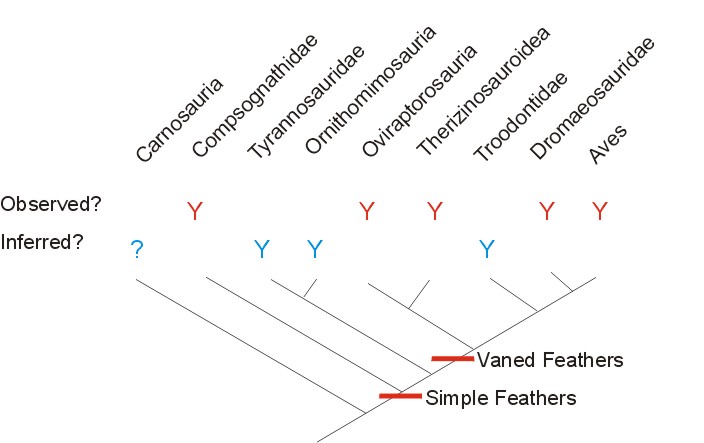GEOL 104 Dinosaurs: A Natural History
Fall Semester 2000
Archaeopteryx and the Origin of Birds II: What is a dinosaur (version 4)?
Under cladistics, birds are the descendants of dinosaurs.
As such, they are descendants of the most recent common ancestor of Megalosaurus
and Iguanodon.
Therefore:
Birds (Aves) are a type of dinosaur!
How do birds fit into dinosaur phylogeny?
Archaeopteryx and later birds have an S-shaped neck, simple hinge ankle joints,
and long hindlimbs:
Birds are ornithodirans
Archaeopteryx and later birds have an inturned femoral head (and upright stance),
and their tibiae, fibulae, and metatarsi are all long and slender:
Birds are dinosauriforms
Archaeopteryx and later birds have a semiopposable manual digit I, reduced (lost)
manual digits IV and IV, more than three sacrals, and (in primitive forms) a perforate
acetabulum:
Birds are dinosaurs
Archaeopteryx and later birds have posterior cervicals longer than their anterior
ones, manual digit II is the longest, and (in primitive forms) a big thumb claw:
Birds are saurischians (and not ornithischians!)
Archaeopteryx and later birds have extremely hollow long bones and an
intramandibular joint:
Birds are theropods
Archaeopteryx and later birds have a promaxillary fenestra (lost in more advanced
birds), five or more sacrals, a furcula, manual digit V is lost, pedal digits I and V are
reduced, and metatarsal I does not contact the ankle:
Birds are neotheropods
Archaeopteryx and later birds have the tooth row anterior to the orbit, a distally
stiffened tail, a semilunate carpal block, large hands, have lost manual digit IV, and
have a tall ascending process of the astragalus:
Birds are tetanurines
Archaeopteryx and later birds have a maxillary fenestra, complex chambers in
their vertebrae, and an obturator process on the ischium:
Birds are avetheropods
Archaeopteryx and later birds have boat-shaped chevrons, a triangular obturator
process, and a very tall ascending process of the astragalus:
Birds are coelurosaurs
Archaeopteryx and later birds have enlarged brain size, a bony palate, and fewer
than 45 caudals:
Birds are maniraptoriforms
Archaeopteryx and later birds have enlarged sterna, shoulder joints that face
laterally, enlarged semilunate carpal blocks, and manual unguals which are very curved
and compressed mediolaterally:
Birds are maniraptorans
Archaeopteryx and later birds have tail which is very mobile proximally but very
stiff distally, a backwards-pointing pubis, and (in primitive forms) a retractable pedal
digit II:
Birds are eumaniraptorans
Avialae (the taxon comprised of Archaeopteryx and more advanced birds) share
the following synapomorphies:
- Flight
- Number of caudals 25 or fewer
- Pedal digit I reversed and at bottom of metatarsus
Many features that characterize modern birds evolved long after Archaeopteryx.
These include:
- Loss of teeth (occurs more than once in bird history)
- Synsacrum
- Pygostyle
- Carpometacarpus
- Tarsometatarsus
All these features worked out by skeletal relationships. New discovery of feathered
coelurosaurs leads to new interpretation of these avian features:

Coelurosauria seems be characterized by feathers, and Maniraptora by vaned feathers.
So, tyrannosaurids and ornithomimosaurs were most likely feathered (or at least
descendants of feathered ancestors)!!
Since feathers are found in non-avian, non-flying dinosaurs, feathers must have evolved
for something other than flight. Possibilities include:
- Insulation
- Warmth for brooding eggs
- Display
- Combination of these
Feathers were thus symplesiomorphies of birds, NOT synapomorphies!
Flight origins:
Two primary models are:
- Trees down:
ancestors of birds were tree-dwellers, birds went through gliding stage
- Ground up:
no arboreal (tree dwelling) phase, nor gliding stage
Still considerable work being done on modern flyers and gliders, so the models for flight
origin are still being worked out.
During Cretaceous, a great burst of bird diversity, including:
- Perching feet
- Toothless beaks (convergent in different bird groups)
- Flightless birds
- Even flightless swimming birds!
Because of the cladistic position of Aves, we now know that Dinosauria is not extinct!
(In fact, it outnumbers mammal species 2:1).
To Next Lecture.
To Previous Lecture.
To Syllabus.
